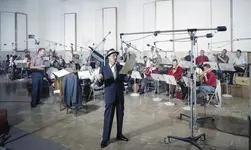Hi - I just watched the video and to be very honest, I think you've completely missed the point in that recording. That is not a 50's recording - it hasn't been recorded like they did it in the 50's, and key features are that the actual style of music does not lend itself to the 50's technique at all. The thing you forgot to mention was that the absolutely vital thing was that in the room, it sounded balanced (not mixed, as you used the term) but all the components blended. Throughout the 50's and then the 60s, track counts were limited and overdubs not very common. The 60's rolled in the concept of overdubbing for popular music. So we're talking Beatles and Beach Boys really pushing the technology as it was developed, or in some cases, invented. In the 50's, your research is quite correct - the room balance just had to be captured, and as long as the room sounded good, then there was no massive need for lots of mics. Remember that ribbons of the STC/Coles/RCA's at that time were NOT lacking in extended HF, because the record players of the time, plus medium wave/long wave radio had very limited bandwidth - so there was no need to use the basic EQ of the time, based on quite simple R/C Baxendale circuits (at least here in the UK), to add anything. You didn't mention that they used the ribbons because you can have two working sides - so two people on each face is easy capture of 4 people, and a little but of people and mic movement sorts the balance. However - if you are making a video on how to recreate the 50's sound, you just cannot do this with only you as a sound source - you said in the video, you cannot play more than one thing at a time, so how can you recreate the sound - it had to be a multitrack, can it be anything else? You appear to have done some research, and drawn some conclusions that are a bit shaky. There are some buddy Holly recordings, from the original master and the audio quality is equal to anything we hear today. It was not a sound that dated it between 50 and 59 at all. It was well recorded and well balanced and all the hiss, distortion and added noise, we heard on the original records was NOT in the actual recording.
If you want to recreate the 50s sound, you need their technique, their method of working and a 50's sounding room. I don't really think your modern music you recorded sounded remotely like the 50's sound - in fact, probably the 70s is more similar to what I heard.
It's not bad - but some of those pictures were way out of period - the Jacksons, for example - that's not 50's.Keep in mind that multi-mic recording DID happen in the 50's - the live musicians and singers, direct to the mixer and recorded

